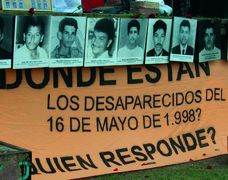Article published in the special Newsletter '15 years of PBI', October 2009
Lars Helmersson, volunteer from Sweden (1995-2004) 1
During their incursion into the capital of the Magdalena Medio region, the paramilitaries murder seven people and disappear another twenty five. The organisations respond with protests and condemnations.
On Saturday 16 May 1998, at eight in the evening, about 50 men dressed in civilian clothes, heavily armed and travelling in four trucks, invaded Barrancabermeja’s south-eastern district. They began rounding up the people they regarded as collaborators with the guerrilla. Those who resisted were murdered on the spot.
Despite the strong army presence in the city and the fact that the action had been announced beforehand 2, the paramilitaries were able to continue with their operation until 11 o’clock that night, and then leave the city with the lorries loaded with the people they had captured 3.
After the first days of confusion, it was established that the death toll from this paramilitary incursion totalled 7 murders and 25 disappearances. A new paramilitary group which called itself AUSAC (Autodefensas de Santander y Sur del César - Santander and Southern César Self-defence Forces) claimed responsibility for the action, arguing that the victims were members of the ELN, although this was denied both by their relatives and by the ELN itself 4.
The strong protests, including a general strike of several days, showed that Barrancabermeja was a force to be reckoned with, that the paramilitaries would not succeed in destroying civil society with similar operations.
The organisations which led the protests and condemnations received many threats and PBI increased its accompaniment of the Regional Corporation for the Defence of Human Rights (CREDHOS) and the Grassroots Women’s Organisation (OFP), so that it was round-the-clock. Despite this, Osiris Bayther Ferias, the then president of the Regional Corporation for the Defence of Human Rights (CREDHOS), was in the end forced to flee the country.
In November of that year, the relatives of the disappeared formed the Barrancabermeja chapter of the Association of Family Members of the Detained and Disappeared (ASFADDES) 5, which received accompaniment from PBI until it closed due to the paramilitary takeover of Barrancabermeja in 2001.
A year after the massacre, a controversial International Tribunal of Opinion was held in Barrancabermeja, which issued a judgment against the Colombian state for its responsibility for the massacre 6.
Although, the information gathered during the testimony of demobilised paramilitaries gave rise to many questions and doubts, it has led to the location of the remains of some of the disappeared. To date, five have been identified 7 and given a burial. According to testimonies by paramilitaries known as «Julián Bolívar» and «El Panadero», they realised that the people they had captured were not really guerrillas8. They stated that it was «Camilo Morantes», the late paramilitary commander who, while on a drinking binge, gave the order to murder them 9. It seems that it is always those now dead who are responsible for the murders. The organisations continue to seek the truth.
1 Lars Helmersson was in PBI for four years between 1995-2004
2 Vanguardia Liberal newspaper, 19 May 1998
3 CREDHOS, 17 May 1998
4 Vanguardia Liberal newspaper, 5 June 1998
5 «Veinte años de historia y lucha», («Twenty years of history and struggle»), ASFADDES, 23 April 2008
6 El Espectador, 17 May 1999
7 Vanguardia Liberal, 8 January 2009
8 Vanguardia Liberal, 13 July 2007
9 Vanguardia Liberal, 23 April 2008

